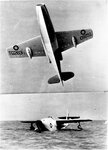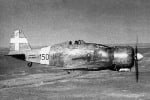johnbr
2nd Lieutenant
Catapult trials of a Loening-Keystone XO2L-1
During the inter-war period, most navies experimented with and perfected the catapult launching of aircraft from ships. The role of ship-launched aircraft for observation, spotting for the guns and scouting was fully recognised. The Loening Company developed, in particular, amphibious seaplanes and the similarity between these amphibians and those of the Grumman company are not fortuitous. Leroy Grumman was General Manager at Loening and when he left the company to start his own, he incorporated many concepts developed at Loening. This photograph shows the sole prototype XO2L-1 sometime around 1932, performance was such that the Navy did not pursue trials, note the arrester hook. Ironically,the Navy went to Grummans looking for a new amphibian and the result was the JF/J2F Duck.
Verso: "Verso: "Navy tests catapults at Washington Navy Yard. Washington D.C. A combination of the oldest and the newest weapons of warfare, the catapult, which hurled missiles into beleaguered cities in the Middle Ages and the airplane of today, has been developed by the U.S. Navy to release planes from small decks of ships and its undergoing tests at the Navy Yard here. This picture shows a thrilling closeup of an amphibian plane as it is hurled into the air after a run of only 60 feet, by the catapult. The carriage and arresting gear of the catapult are also shown in the photo".

20cm x 15cm Gelatin silver print
During the inter-war period, most navies experimented with and perfected the catapult launching of aircraft from ships. The role of ship-launched aircraft for observation, spotting for the guns and scouting was fully recognised. The Loening Company developed, in particular, amphibious seaplanes and the similarity between these amphibians and those of the Grumman company are not fortuitous. Leroy Grumman was General Manager at Loening and when he left the company to start his own, he incorporated many concepts developed at Loening. This photograph shows the sole prototype XO2L-1 sometime around 1932, performance was such that the Navy did not pursue trials, note the arrester hook. Ironically,the Navy went to Grummans looking for a new amphibian and the result was the JF/J2F Duck.
Verso: "Verso: "Navy tests catapults at Washington Navy Yard. Washington D.C. A combination of the oldest and the newest weapons of warfare, the catapult, which hurled missiles into beleaguered cities in the Middle Ages and the airplane of today, has been developed by the U.S. Navy to release planes from small decks of ships and its undergoing tests at the Navy Yard here. This picture shows a thrilling closeup of an amphibian plane as it is hurled into the air after a run of only 60 feet, by the catapult. The carriage and arresting gear of the catapult are also shown in the photo".
20cm x 15cm Gelatin silver print





